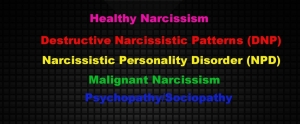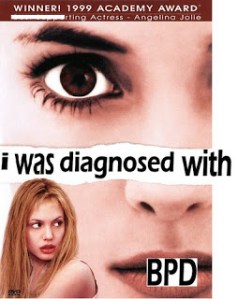Interesting article about the lesser-known indicators of narcissism from Psychology Today. Contrary to popular opinion, narcissists do not love themselves, only their image.
I agree with Dr. Seltzer that these six traits should be added to the official diagnostic criteria for NPD.
6 Signs of Narcissism You May Not Know About: How can you recognize the fragility behind the narcissist’s grandiosity?
Post published by Leon F Seltzer Ph.D.

The recently published 5th edition of the Diagnostic and Statistical Manual of Mental Disorders (DSM) lists precisely the same nine criteria for narcissistic personality disorder (NPD) as did the previous version, published 19 years earlier. So these longstanding diagnostic yardsticks are by now quite familiar—not only to professionals but to interested laypeople as well. Because only the extreme, or “classic,” narcissist fits all of these criteria, DSM specifies that an individual need meet only five of them (barely more than half) to warrant this unflattering label.
As a starting point, I’ll reiterate these selected criteria—before, that is, adding six important ones of my own, which either complement or extend these “official” yardsticks. My particular measures for identifying pathological narcissists are based not only on my exposure to the voluminous writings on this character disorder, but also on 30+ years of clinical experience. This experience includes doing personal, couples, and family counseling with such troublesome individuals. But it also involves working independently with those involved with narcissists—whether their distressed children, spouses, parents, friends, or business associates—who repeatedly express enormous frustration in trying to cope with them.
To begin, however, here are DSM’s requirements (link is external) (slightly condensed, and with minor bracketed amendments) for “earning” the unenviable diagnosis of Narcissistic Personality Disorder:
1. Has a grandiose sense of self-importance.
2. Is preoccupied with fantasies of unlimited success, power, brilliance, beauty, or ideal love.
3. Believes that he or she is “special” and unique and can only be understood by, or should associate with, other special or high-status people (or institutions).
4. Requires excessive admiration [regularly fishes for compliments, and is highly susceptible to flattery].
5. Has a sense of entitlement.
6. Is interpersonally exploitative.
7. Lacks empathy: is unwilling [or, I would add, unable] to recognize or identify with the feelings and needs of others.
8. Is often envious of others or believes that others are envious of him or her.
9. Shows arrogant, haughty [rude and abusive] behaviors or attitudes.
So what’s left out here? Actually, as regards identifying descriptors, quite a bit. And I’ve no doubt that other therapists could add further to the six additional characteristics I’ll provide here—features that, although regrettably minimized or omitted from DSM, I‘ve routinely seen displayed by the many dysfunctional narcissists I’ve worked with. So, to enumerate them, such individuals:
1. Are highly reactive to criticism.

Or anything they assume or interpret as negatively evaluating their personality or performance. This is why if they’re asked a question that might oblige them to admit some vulnerability, deficiency, or culpability, they’re apt to falsify the evidence (i.e., lie—yet without really acknowledging such prevarication to themselves), hastily change the subject, or respond as though they’d been asked something entirely different. Earlier for Psychology Today I wrote a post highlighting this supercharged sensitivity called “The Narcissist’s Dilemma: They Can Dish It Out, But . . . ”. And this aspect of their disturbance underscores that their ego—oversized, or rather artificially “inflated”—can hardly be viewed as strong or resilient. On the contrary, it’s very easily punctured. (And note here another related piece of mine, “Our Egos: Do They Need Strengthening—or Shrinking?”). What these characteristics suggest is that, at bottom and despite all their egotistic grandiosity, they…
2. Have low self-esteem.

This facet of their psyche is complicated, because superficially their self-regard would appear to be higher and more assured than just about anyone else’s. Additionally, given their customary “drivenness,” it’s not uncommon for them to rise to positions of power and influence, as well as amass a fortune (and see here my post “Narcissism: Why It’s So Rampant in Politics”). But if we examine what’s beneath the surface of such elevated social, political, or economic stature—or their accomplishments generally—what typically can be inferred is a degree of insecurity vastly beyond anything they might be willing to avow.
That is, in various ways they’re constantly driven to prove themselves, both to others and to their not-so-confident “inner child” self. This is the self-doubting, recessive part of their being that, though well hidden from sight, is nonetheless afflicted with feelings and fears of inferiority. Inasmuch as their elaborate defense system effectively wards off their having to face what their bravado masks, they’re highly skilled at exhibiting, or “posturing,” exceptionally high self-esteem. But their deeper insecurities are yet discernible in their so often fishing for compliments and their penchant for bragging and boasting about their (frequently exaggerated) achievements. That is, they’re experts at complimenting themselves! And when—despite all their self-aggrandizement— others are critical of them, they…
3. Can be inordinately self-righteous and defensive.

Needing so much to protect their overblown but fragile ego, their ever-vigilant defense system can be extraordinarily easy to set off. I’ve already mentioned how reactive they typically are to criticism, but in fact anything said or done that they perceive as questioning their competence can activate their robust self-protective mechanisms. Which is why so many non-narcissists I’ve worked with have shared how difficult it is to get through to them in situations of conflict. For in challenging circumstances it’s almost as though their very survival depends on being right or justified, whereas flat out (or humbly) admitting a mistake—or, for that matter, uttering the words “I’m sorry” for some transgression—seem difficult to impossible for them.
Further, their “my way or the highway” attitude in decision-making—their stubborn.competitive insistence that their point of view prevail—betrays (even as it endeavors to conceal) their underlying doubts about not being good, strong, or smart enough. And the more their pretentious, privileged, exaggeratedly puffed-up self-image feels endangered by another’s position, the more likely they are to…
4. React to contrary viewpoints with anger or rage.

In fact, this characteristic is so common in narcissists that it’s always surprised me that DSM doesn’t specifically refer to it among its nine criteria. Repeatedly, writers have noted that angry outbursts are almost intrinsic to both narcissistic and borderline personality disorders. And although (unlike the borderline) it’s not particular fears of abandonment that bring out their so-called “narcissistic rage,” both personality disorders generally react with heated emotion when others bring their deepest insecurities too close to the surface.
The reason that feelings of anger and rage are so typically expressed by them is that in the moment they externalize the far more painful anxiety- or shame-related emotions hiding just beneath them. When they’re on the verge of feeling—or re-feeling—some hurt or humiliation from their past, their consequent rage conveniently “transfers” these unwanted feelings to another (and see here my PT post “Anger—How We Transfer Feelings of Guilt, Hurt, and Fear”).
The accompanying message that gets communicated through such antagonistic emotions is “I’m not bad (wrong, stupid, mean, etc.), you are!” Or, it could even be: “I’m not narcissistic, or borderline! You are!” (Or, in slightly milder version, “If I’m narcissistic, or borderline, then so are you!”) And if the mentally healthier individual has no clue as to what provoked their outburst in the first place, such a sudden explosion is likely to make them feel not only baffled but hurt, and maybe even frightened. But what cannot be overemphasized here is that narcissists…
5. Project onto others qualities, traits, and behaviors they can’t—or won’t—accept in themselves.

Because they’re compelled from deep within to conceal deficits or weaknesses in their self-image, they habitually redirect any unfavorable appraisal of themselves outwards, unconsciously trusting that doing so will forever keep at bay their deepest suspicions about themselves. Getting anywhere close to being obliged to confront the darkness at their innermost core can be very scary, for in reality their emotional resources are woefully underdeveloped.
Broadly recognized as narcissists by their fundamental lack of self-insight, very few of them (depending, of course, on how far out they are on the narcissistic continuum) can achieve such interior knowledge. For in a variety of ways their rigid, unyielding defenses can be seen as more or less defining their whole personality. And that’s why one of the most reliable ways for them to feel good about themselves—and “safe” in the world they’re essentially so alienated from—is to invalidate, devalue, or denigrate others. So they’ll focus on others’ flaws (whether or not they really exist) rather than acknowledge, and come to terms with, their own. And in many curious ways this habit causes them to…
6. Have poor interpersonal boundaries.

Space invasion!
It’s been said about narcissists that they can’t tell where they end and the other person begins. Unconsciously viewing others as “extensions” of themselves, they regard them as existing primarily to serve their own needs—just as they routinely put their needs before everyone else’s (frequently, even their own children). Since others are regarded (if they’re regarded at all!) as what in the literature is often called “narcissistic supplies”—that is, existing chiefly to cater to their personal desires—they generally don’t think about others independently of how they might “use” them to their own advantage. Whatever narcissists seek to give themselves, they generally expect to get from others, too (which is yet another dimension of their famous—or infamous—sense of entitlement).
Even beyond this, their porous boundaries and unevenly developed interpersonal skills may prompt them to inappropriately dominate conversations and share with others intimate details about their life (though some narcissists, it should be noted, can display an extraordinary, however Machiavellian, social savvy). Such private information would probably focus on disclosing facts others would be apt to withhold. But having (at least consciously) much less of a sense of shame, they’re likely to share things they’ve said or done that most of us would be too embarrassed or humiliated to admit. Still, with an at times gross insensitivity to how others might react to their words, they’re likely to blurt out things, or even boast about them, that others can’t help but view as tasteless, demeaning, insulting, or otherwise offensive.
They might, for instance, share—and with considerable pride!—how they “chewed” someone out, and expect the other person to be impressed by their courage or cleverness, when in fact the listener may be appalled by their lack of kindness, tact, or restraint. Additionally, they may ask others questions that are far too personal or intimate—again unwittingly irritating or upsetting them. And such a situation can be particularly difficult for the other person if the narcissist is in a position of authority over them so that not responding could, practically, put them in some jeopardy.
To conclude, I can only hope that these additional characterizations of the pathological narcissist (vs. those with less pronounced narcissistic qualities) may be helpful in enabling you to identify them before their “malignancy” does a number on you. And if you’ve already been duped by their machinations or manipulations, perhaps this piece will be a “heads up” for you to prevent them from wreaking any further havoc in your life.
NOTE 1: I’d be remiss if I didn’t point out that the narcissism addressed here centers on its most maladaptive, or “toxic,” forms. Unlike DSM (the standard diagnostic reference tool for mental health professionals), the Psychodynamic Diagnostic Manual (link is external)(PDM, 2006)—respected, but much less well known than this official volume—explicitly notes that the disorder exists “along a continuum of severity, from the border with neurotic personality disorders to the more severely disturbed levels.” And additionally, that “toward the neurotic end [these] narcissistic individuals may be socially appropriate, personally successful, charming and, although somewhat deficient in the capacity for intimacy, reasonably well adapted to their family circumstances, work, and interests.”
























